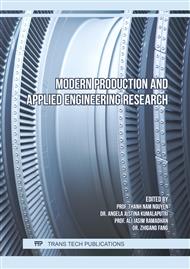[1]
G. Ambrogio and L. Filice, On the use of Back-drawing Incremental Forming (BIF) to improve geometrical accuracy in sheet metal parts, International Journal of Material Forming, vol. 5, no. 4, 2012, p.269–274.
DOI: 10.1007/s12289-011-1053-8
Google Scholar
[2]
J. Jeswiet, F. Micari, G. Hirt, A. Bramley, J. Duflou, and J. Allwood, Asymmetric single point incremental forming of sheet metal, CIRP Annals, vol. 54, no. 2, 2005, p.88–114.
DOI: 10.1016/s0007-8506(07)60021-3
Google Scholar
[3]
G. Ambrogio, L. De Napoli, L. Filice, F. Gagliardi, and M. Muzzupappa, Application of Incremental Forming process for high customised medical product manufacturing, Journal of Materials Processing Technology, vol. 162-163, 2005, p.156–162.
DOI: 10.1016/j.jmatprotec.2005.02.148
Google Scholar
[4]
V. Oleksik, A. Pascu, C. Deac, R. Fleaca, M. Roman, and O. Bologa, The influence of geometrical parameters on the incremental forming process for knee implants analyzed by numerical simulation, in Proceedings of the NUMIFORM, Pohang, Republic of Korea, June 2010, p.1208–1215.
DOI: 10.1063/1.3457520
Google Scholar
[5]
A. Attanasio, E. Ceretti, C. Giardini, and L. Mazzoni, Asymmetric two points incremental forming: improving surface quality and geometric accuracy by tool path optimization, Journal of Materials Processing Technology, vol. 197, no. 1–3, 2008, p.59–67.
DOI: 10.1016/j.jmatprotec.2007.05.053
Google Scholar
[6]
H. Iseki and H. Kumon, Forming limit of incremental sheet metal stretch forming using spherical rollers, Journal-Japan Society for Technology of Plasticity, vol. 35, no. 11, 1994, p.1336.
Google Scholar
[7]
H. Iseki, K. Kato, and S. Sakamoto, Flexible and incremental sheet metal forming using a spherical roller, in Proceedings of the 40th JJCTP in Japanese, 1989, p.41–44.
Google Scholar
[8]
G. Ambrogio, I. Costantino, L. De Napoli, L. Filice, L. Fratini, and M. Muzzupappa, Influence of some relevant process parameters on the dimensional accuracy in incremental forming: a numerical and experimental investigation, Journal of Materials Processing Technology, vol. 153-154, 2004, p.501–507.
DOI: 10.1016/j.jmatprotec.2004.04.139
Google Scholar
[9]
E. Hagan and J. Jeswiet, A review of conventional and modern single-point sheet metal forming methods, Proceedings of the Institution of Mechanical Engineers, Part B: Journal of Engineering Manufacture, vol. 217, no. 2, 2003, p.213–225.
DOI: 10.1243/095440503321148858
Google Scholar
[10]
J. Jeswiet, E. Hagan, Analysis of surface roughness for parts formed by CNC incremental forming, Proc. Instn Mech. Engers. 218 (2004), p.1307–1312.
Google Scholar
[11]
K. Allan, S. Hamilton, FRICTION AND EXTERNAL SURFACE ROUGHNESS IN SINGLE POINT INCREMENTAL FORMING: A study of surface friction, contact area and the "orange peel" effect, (2010).
Google Scholar
[12]
B.M. Powers, M. Ham, M.G. Wilkinson, Small data set analysis in surface metrology: An investigation using a single point incremental forming case study, Scanning. 32 (2010) 199–211.
DOI: 10.1002/sca.20202
Google Scholar
[13]
M. Durante, A. Formisano, A. Langella, Comparison between analytical and experimental roughness values of components created by incremental forming, J. Mater. Process. Technol. 210 (2010) 1934–1941.
DOI: 10.1016/j.jmatprotec.2010.07.006
Google Scholar
[14]
S. Kurra, N.H. Rahman, S.P. Regalla, A.K. Gupta, Modeling and optimization of surface roughness in single point incremental forming process, Integr. Med. Res. 4 (2015) 304–313.
DOI: 10.1016/j.jmrt.2015.01.003
Google Scholar
[15]
M. Durante, A. Formisano, and A. Langella, Comparison between analytical and experimental roughness values of components created by incremental forming, Journal of Materials Processing Technology, vol. 210, no. 14, 2010, p.1934–1941.
DOI: 10.1016/j.jmatprotec.2010.07.006
Google Scholar
[16]
Z. Liu, S. Liu, Y. Li, and P. A. Meehan, Modeling and optimization of surface roughness in incremental sheet forming using a multi-objective function, Materials and Manufacturing Processes, vol. 29, no. 7, 2014, p.808–818.
DOI: 10.1080/10426914.2013.864405
Google Scholar
[17]
I. Bagudanch, M. L. Garcia-Romeu, G. Centeno, A. ElıasZuniga, and J. Ciurana, Forming force and temperature effects on single point incremental forming of polyvinylchloride, Journal of Materials Processing Technology, vol. 219, 2015, p.221–229.
DOI: 10.1016/j.jmatprotec.2014.12.004
Google Scholar
[18]
V. Mugendiran, A. Gnanavelbabu, and R. Ramadoss, Parameter optimization for surface roughness and wall thickness on AA5052 Aluminium alloy by incremental forming using response surface methodology, Procedia Engineering, vol. 97, 2014, p.1991–2000.
DOI: 10.1016/j.proeng.2014.12.442
Google Scholar
[19]
Serope Kalpakjian, Steven R. Schmid, Manufacturing Processes for Engineering Materials, Addision-Wesley Publishing Company, 2014, p.376–380.
Google Scholar
[20]
K, Ajay. Mittal Ravi Kant, Incremental sheet forming technologies: Principles, merits, limitations, and applications, Taylor & Francis Group, New York, 2020, p.32–34.
DOI: 10.1201/9780429298905-2
Google Scholar
[21]
Abdulmajeed Dabwan, Adham E. Ragab, Mohamed A. Saleh, Saqib Anwar, Atef M. Ghaleb, and Ateekh Ur Rehman, Study of the Effect of Process Parameters on Surface Profile Accuracy in Single-Point Incremental Sheet Forming of AA1050-H14 Aluminum Alloy, Advances in Materials Science and Engineering Volume 2020, p.1–12.
DOI: 10.1155/2020/7265941
Google Scholar
[22]
Nguyen Thanh Nam, Le Khanh Dien, Phan Dinh Tuan, Nguyen Thien Binh, Working practical guide for incremental deformation, Publishing of National University HCMC, 2010, pp.8-31.
Google Scholar
[23]
J. Jeswiet, F. Micari, G. Hirt. A. Bramley, J. Duflou, J. Allwood. Asymmetric Single Point Incremental Forming of Sheet Metal, Ann. CIRP Annals, 54, 2005, pp.623-649.
DOI: 10.1016/s0007-8506(07)60021-3
Google Scholar
[24]
Kumar, Ajay, and Vishal Gulati, Experimental Investigation and Optimization of Surface Roughness in Negative Incremental Forming, Measurement 131 (2019): 419–430.
DOI: 10.1016/j.measurement.2018.08.078
Google Scholar
[25]
Kumar, Ajay, Vishal Gulati, and Parveen Kumar, Investigation of Surface Roughness in Incremental Sheet Forming, Procedia Computer Science 133 (2018): 1014–1020.
DOI: 10.1016/j.procs.2018.07.074
Google Scholar


